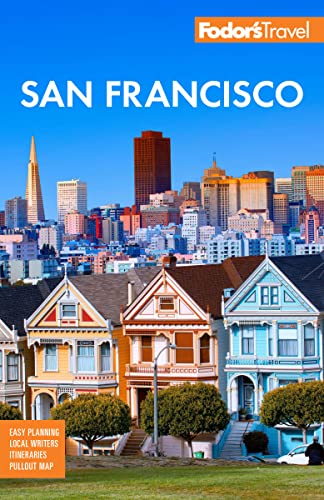Dining
San Francisco is one of America’s top food cities. Some of the biggest landmarks are restaurants, and, for some visitors, chefs are just as big a draw as Alcatraz. In fact, on a Saturday, the Ferry Building—a temple to local eating—may attract more visitors than the Golden Gate Bridge.
Chefs are drawn to the superb ingredients plucked from the soil and the sea. Chances are that the Meyer lemons, fava beans, or strawberries on your plate that are preserved, pureed, or pickled were harvested within the last 48 hours, if not this morning. The briny abalone, crab, oysters, squid, and tuna that are poached, seared, smoked, or carpaccio’ed are caught just offshore. You will also get to taste unusual varieties, like lollipop kale, agretti greens, and yuzu citrus.
Today the most interesting kitchens are using these ingredients in regional cuisines, like Korean, Japanese, Italian, or South American. So get ready to dig into kung pao pastrami, porcini doughnuts with raclette béchamel, and yucca gnocchi. That fig-on-a-plate reputation? That’s so last decade.
But the playground isn't just in haute cuisine kitchens. Culinary hot spots are just as likely to be a burger, pizza, or barbecue joint—with a few classically trained chefs dedicating their lives to making a better margherita pizza. And you can just as easily find superb banh mi, ramen noodles, and juicy al pastor tacos in the kitchens of Little Saigon, Japantown, or the Mission District.
The impact of the COVID-19 pandemic on the restaurant scene in the Bay Area, as in many other parts of the globe, has been widespread and severe. Many restaurants and bars have responded with adjusted hours, changed menus, and limited indoor or only outdoor seating. Call the restaurant or check their website for the latest information. One upside is that temporary parklets and pedestrian-friendly slow streets may become permanent fixtures, lending an air of alfresco European leisure to the streets of San Francisco.
Reservations
Snagging reservations at restaurants with a lot of buzz has gotten notoriously difficult, with 5:30 or 9:30 often the pick. These choices aren’t terrible, if you plan on it. For a reservation at peak dining hours, though, our best advice is to call as far in advance as possible—try eating there earlier in the week if the Friday and Saturday tables are full. You can also try calling a restaurant in the early afternoon the day of, when they're making their reservation confirmation calls and may have a last-minute opening. If you're calling a few days ahead of time, ask if you can be put on a waiting list. Also, ask whether there’s a bar or counter you can dine at—these are usually offered first-come, first-served. Some places set aside tables for walk-in business (and not for advance reservations), in which case you can just show up and make the most of the wait. As a last resort, many popular San Francisco restaurants are also open for lunch.
Hours
Unless otherwise noted, the restaurants listed are open daily for lunch and dinner. Prime time for dinner is around 7:30 or 8 pm, and although there are places for night owls to fuel up, most restaurants stop serving around 10 pm. Restaurants, along with bars and clubs, may serve alcohol between the hours of 6 am and 2 am.
What to Wear
In general, San Franciscans are neat but casual dressers; only at the top-notch dining rooms do you see a more formal style. But the way you dress may influence how you're treated—and where you're seated. Generally speaking, jeans will suffice at most table-service restaurants in the $ to $$$ range. A few pricier restaurants require jackets, and some insist on ties. In reviews, we mention dress only when men are required to wear a jacket or a jacket and tie. Note that shorts, sweatpants, and sports jerseys are rarely appropriate. When in doubt, call the restaurant and ask.
Children
As in many other cities, small kids generally aren't seen in the fanciest restaurants. For families with young children, we recommend many family-friendly places with great food. Restaurants that are particularly good for families are marked as such.
Parking
Most high-end restaurants offer valet parking—worth considering in crowded neighborhoods, such as North Beach, Russian Hill, Union Square, and the Mission. There's often a nominal charge and a time restriction on validated parking.
Prices
If you're watching your budget, be sure to ask the price of daily specials. The charge for these dishes can sometimes be out of line with the menu. If you eat early or late, you may be able to take advantage of a prix-fixe deal not offered at peak hours. Many upscale restaurants offer lunch deals with special menus at bargain prices. Credit cards are widely accepted, but some restaurants (particularly smaller ones) accept only cash. Also, keep in mind that a restaurant listed as $$$ may actually have a good deal or two, such as an early prix-fixe dinner or a great bar scene and good, reasonably priced bar food to go with it.
Tipping and Taxes
In most restaurants, tip the waiter 18%–20%. (To figure out a 20% tip quickly, just move the decimal spot one place to the left of your pretax bill and double that.) Bills for parties of six or more sometimes include the tip (you can always add more). A few restaurants in the Bay Area are experimenting with a gratuity-included policy for all parties. There are only a handful of such places, and the movement is led by some of the best chefs. Tip at least $1 per drink at the bar; $2 if it’s a labor-intensive cocktail. Also be aware that some restaurants, now required to fund the city's new universal-health-care ordinance, are passing these costs along to their customers indirectly instead of raising menu prices—usually in the form of a 3%–4% surcharge or a $1–$3.50-per-head charge. (San Francisco sales tax is currently at 8.5%.)




